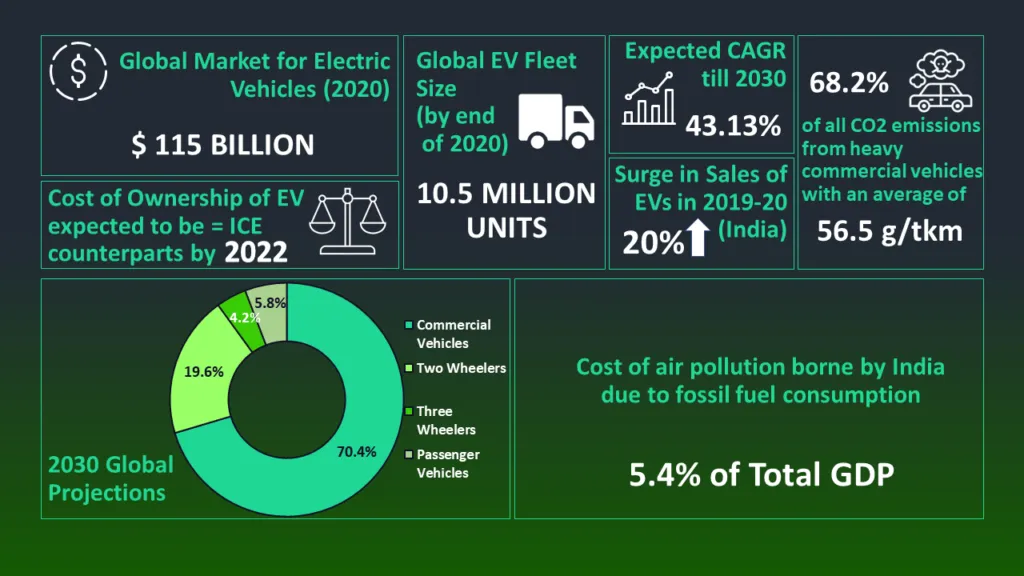Cell Propulsion - What made us cross the Chasm?

The 4th-largest automobile industry in the world needs a transformation - especially the commercial segment which comprises nearly 4% of the industry. Also, the world continues to grapple with climate change, as the stakes keep getting exponentially higher with each passing year. Cell Propulsion presents its solution as a model that is unique for multiple reasons, including but not limited to scalability, customization for the end customer, and a product that offers numerous avenues for diversification.
India’s automobile segment has seen better days. The rising volatility in fuel prices coupled with the high cost of operations are hurting Fleet owners & Operators (large sections of which are SME/MSMEs). The fourth-largest automobile industry in the world needs a transformation - especially the commercial segment which comprises nearly 4% of the industry but is afflicted with bleak financial profiles of the fleet operators as well as price hikes due to the transition to BS-VI norms which have caused sales to plummet even further. There is immense scope for optimization of the entire supply chain of this segment as there is a shift towards its electrification.
Adding on to that, the world continues to grapple with climate change, as the stakes keep getting exponentially higher with each passing year. With increasing urbanization and the imminent threat of traffic congestion leading to unprecedented levels of pollution - there is a growing space for technology that can alleviate this issue. Since commercial vehicular emissions contribute a significant portion of the most hazardous pollutants responsible for this problem, intelligent electric mobility presents a key step towards the larger goal of clean energy.
In the past few years, Endiya Partners has seen several EV ideas from a gamut of players across the EV spectrum today. However, Cell Propulsion presents its solution as a model that is unique for multiple reasons, including but not limited to, scalability, customization for the end customer, and a product that offers numerous avenues for diversification.

Why Now? - EV Adoption
Electric Vehicles are a more than viable substitute for their ICE (Internal Combustion Engine) counterparts and one of the important pieces in the global climate change combat strategy. Policymakers and governments in India and around the world have extended considerable support in enabling an EV ecosystem with the objective of pollution control. Customer reception has also been positive - even in a country like India where the success of electric two-wheelers has been noteworthy - with 152,00 units being sold in fiscal 2020. Overall, the EV market is set to expand further with the radical changes in transport systems expected in a post-COVID-19 scenario, already having gained a net increase of 20% in sales over the previous year.
With a lesser number of parts and potential intelligent Ops, EVs are superior technology to the ICE. In addition, the increased capacity of the industry in Li-ion battery manufacturing - from nearly 0 in 2010 to 300 Gwh in 2020 - as well as the fall in battery prices by almost 85% from $ 1000/kWh to $ 150/kWh, the total cost of ownership (TCO) for EVs has considerably reduced.
The electric revolution is slowly enabling an EV ecosystem which includes pure-play OEMs who develop the core and adjacent infrastructure end-to-end, as well as CPOs or Charge Point Operators who support EV adoption and are backed by traditional energy companies.
With growing economic viability and maturing EV ecosystem enabling the ease of adoption for a large and untapped market, Electric Mobility is on the cusp of a breakthrough.
Why Commercial Vehicles? - Natural Fit
Owing to greater distances and heavier loads covered, high payload light commercial vehicles and heavy-duty vehicles such as trucks and buses also need more powerful batteries. However, opportunities are abundant. Given the controlled environment in which commercial vehicles, such as logistics fleet operators or local public transport, operate - it is much easier to provide and optimize the required infrastructure support. Since the routes and distances are fixed, there is an ease of standardization and accessibility of charging support, asset financing etc.
Moreover, the segment simply presents greater economic viability. The frequency of usage of vehicles in this segment is much higher and more widespread. The economic feasibility only amplifies for operators running multiple fleets.
The commercial segment is also the major contributor to greenhouse gas emissions since they make up a significant share of traffic in cities. The CVs with diesel engines emit more particulate matter than gasoline engines. The electrification of this segment is bound to have a maximum impact on reigning in pollution.
Why Cell Propulsion? - Tech with a Solution Centric Approach
Team with Engineering Acumen and Big Vision - Having worked together at ISRO for several years, the core founding team brings a deep understanding of the underlying propulsion technology, design, and core engineering of the high payload eLCV and eHCV tech. What inspired us more, is the team's vision to go big with a uniquely solution-oriented approach.
Indigenized Tech Driving Customer Experience - Given engineering constraints and complexities, efficient high payload, high power eLCV & eHCV segments are still a play for few and far. Cell Propulsion’s vertically integrated indigenized and intelligent ePowertrains which can be efficiently configured for various CVs at an economic price point, provide a compelling tech value proposition. The ability for high customization/configuration at affordable price points while ensuring local product customer support, goes a long way in establishing customer experience.
Quicker Adoption - Focused initial Go2Market around re-manufactured electrified fleets results in faster market adoption and customer conversions, thereby helping gain an early foothold.
Scalability and Transition - Company’s solution-centric full-stack approach (via partnerships with ancillary players in the value chain such as Charging Infra Providers, Asset Financiers, Network of After-Sales Support) is not only targeted towards large-scale electrification of commercial vehicles but also ensures a seamless transition for the end-customers.
Endiya Partners is excited to extend its support to Cell Propulsion as it builds a strong foundation for market leadership. The Company, with its proprietary offering, complements the ‘Make in India’ and ‘Atmanirbhar’ Bharat efforts, which are a pivotal step towards building a more resilient, self-sufficient India. We expect potential tailwinds in the post-COVID world. Already, there is incredible traction in the logistics space as EV technology is bound to revolutionize the supply chain. With authorities pushing for sustainability and a localized supply chain, the EV dream for Light and Heavy Commercial applications is well within the reach, with Cell Propulsion leading from the front.





